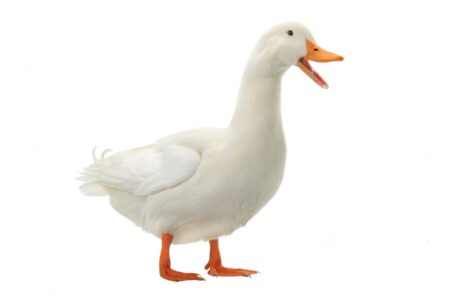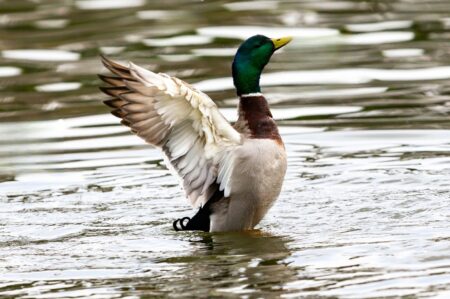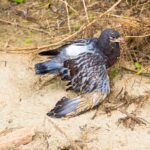Are Ducks Birds? We Have The Answer
Ducks are a common sight in many bodies of water around the world. With their iconic waddling walk and distinctive quacking sound, these feathered creatures have captured the interest of many people. But have you ever wondered, are ducks actually birds?
The answer is yes, ducks are indeed birds. In fact, they belong to a special group of birds known as waterfowl. This classification includes ducks, geese, and swans, all of which are aquatic birds that spend most of their time in and around water.
But what exactly makes ducks birds? Let’s take a closer look at some characteristics that define birds and see how ducks fit into the picture.
Are Ducks Birds? We Have The Answer
Yes, ducks are birds. They belong to the order Anseriformes, which includes more than 160 species of ducks, geese, and swans. All species within this order have several characteristics in common, such as a streamlined body, webbed feet, and a broad, flat beak.
Like all other birds, ducks also have wings and feathers. They are warm-blooded animals and lay eggs, which are two key features of all birds. Ducks have a unique gland called the preen gland, which secretes oil to waterproof their feathers.
Ducks are also able to fly, although not all species do so regularly. Their webbed feet and waterproof feathers make them excellent swimmers, and they are often found in or near bodies of water such as ponds, lakes, and rivers.
In summary, ducks have all the traits and characteristics of birds, making them a part of the diverse and fascinating avian family.
What Is A Bird?
A bird is a warm-blooded vertebrate animal belonging to the class Aves in the animal kingdom. They are characterized by having feathers, wings, a beak, and the ability to lay eggs. They have a lightweight and streamlined body, adapted for flight and locomotion. Unlike other animals, birds have a unique respiratory system that allows them to take in oxygen more efficiently during flight.
Birds come in a wide range of sizes, shapes, and colors, with the smallest being the Bee hummingbird, which is just 2 inches long, and the largest being the ostrich, which can grow up to 9 feet tall. They also have different types of beaks and feet, adapted for their specific diet and habitat.
There are more than 10,000 species of birds found all over the world, living in various habitats such as forests, deserts, oceans, and even urban areas. They play a vital role in the ecosystem as pollinators, seed dispersers, and pest controllers.
In addition to their ability to fly, birds are also known for their intricate songs and calls, which are used for communication and mating purposes. They have highly developed senses, particularly vision and hearing, which help them navigate through their environment and find food.
Some birds are considered domesticated animals, such as chickens and ducks, while others are kept as pets for their companionship, such as parrots and canaries. Overall, birds are fascinating creatures that have captured the curiosity and admiration of humans for centuries.
SEE ALSO: What To Do With An Injured Bird: The Ultimate Guide
Common Characteristics of a Bird
- Feathers: One of the most distinctive features of birds is their feathers. These unique structures cover most of a bird’s body and serve many purposes, including insulation, flight, and display.
- Wings: Most birds have wings, which are used for flying and gliding. While not all birds are capable of sustained flight, their wings are still used for balance and coordination while walking or swimming.
- Beak: Instead of teeth, birds have beaks that vary in shape and size depending on their diet and feeding habits. Beaks can be used for catching and eating food, grooming, and even as weapons for defense.
- Lightweight Bones: Birds have hollow bones that make them lightweight and help with flying. These bones are also strong and reinforced with internal struts, making them more resistant to breaking.
- Warm-Blooded: Like mammals, birds are warm-blooded, meaning they can maintain a stable body temperature regardless of their environment. This allows them to thrive in a wide range of habitats.
- Four-Chambered Heart: Birds have a four-chambered heart, just like mammals, which improves their ability to circulate oxygen and nutrients throughout their body.
- Oviparous: Most birds lay eggs, which are incubated until they hatch. This process, known as oviparity, allows birds to reproduce and continue their species.
- Efficient Respiratory System: Birds have a unique respiratory system that allows for a continuous flow of oxygen to their muscles. This enables them to sustain long periods of flying without getting tired.
- Beating Hearts: Like other animals, birds have a beating heart that pumps blood throughout their body. Some species of birds have a very high heart rate, up to 1200 beats per minute, to help power their flight.
- Strong Navigational Skills: Many birds have a strong sense of navigation and are able to migrate long distances between their breeding and non-breeding grounds each year. Some species even use the stars or Earth’s magnetic field to navigate.
- Care for Young: Most birds care for their young after they hatch, providing food, and protection, and teaching them important life skills. Some bird species also form strong bonds with their mates and raise their young together.
- Unique Vocalizations: Birds have a wide range of vocalizations, from simple chirps to complex songs. These vocalizations are used to communicate with other birds, attract mates, and defend their territory.
- Adaptability: Birds are incredibly adaptable creatures, able to survive and thrive in many different environments. This adaptability has allowed them to evolve and diversify into over 10,000 different species.
- Highly Evolved Brains: Birds have highly evolved brains, with some species having the ability to solve complex problems, use tools, and even mimic human speech.
- Social Creatures: Many bird species are highly social and live in flocks or colonies. Living in groups can provide them with protection, help them find food, and improve their chances of successfully reproducing.
The Characteristics of Ducks
- Webbed Feet: Ducks have webbed feet which are specially designed for swimming. The webbing between their toes helps them to paddle through the water with ease. This adaptation also allows them to walk on muddy or soft surfaces without sinking.
- Waterproof Feathers: A duck’s feathers are coated with an oily substance that makes them waterproof. This allows them to float on the water without getting wet and also helps them to stay warm in cold water.
- Beak: A duck’s beak is designed for foraging and filtering food from the water. It is broad and flat with tiny ridges on the edges, allowing them to sift through mud and sediment for food. Some species also have serrated edges on their beaks for slicing through plants.
- Flexible Neck: Ducks have a long and flexible neck that allows them to reach underwater to feed on plants and small invertebrates.
- Wide Body: Ducks have a wide and round body, which helps them to stay buoyant in the water. It also provides insulation, keeping them warm in the cold water.
- Plumage: Most ducks have a variety of colorful feathers that help them attract mates and identify individuals within a species. These feathers also provide insulation and help with flying.
- Warm-Blooded: Like all birds, ducks are warm-blooded, meaning they can regulate their body temperature regardless of the external temperature. This allows them to live in a wide range of environments.
- Social Behavior: Ducks are social birds and often live in groups called flocks. They communicate with each other through a variety of vocalizations and body movements.
- Migration: Many species of ducks are migratory, meaning they travel long distances between breeding and wintering grounds. This allows them to take advantage of different food sources and habitats throughout the year.
- Omnivorous Diet: Ducks have a varied diet, feeding on a variety of plants, seeds, insects, and small aquatic animals. Some species, such as mallards, will also scavenge human scraps.
How Many Chambers Do Duck Hearts Have?
Duck hearts typically have four chambers, like most other avian species. These chambers are the left atrium, right atrium, left ventricle, and right ventricle.
Types of Ducks
- Mallard Duck: The Mallard Duck (Anas platyrhynchos) is the most common and well-known type of duck, found throughout North America, Europe, and Asia. They have a distinct green head, white neck ring, and brownish body. They are dabbling ducks, meaning they feed on aquatic plants by tipping their heads and necks into the water.
- Wood Duck: The Wood Duck (Aix sponsa) is a North American species known for its beautiful plumage and unique patterns. The male has a colorful head pattern with a green, purple, and white iridescent sheen, while the female is less showy with a gray-brown head and a white eye ring. Wood Ducks are cavity nesters, often choosing hollow trees near water to raise their young.
- Muscovy Duck: The Muscovy Duck (Cairina moschata) is a large, domesticated duck found in Central and South America, as well as in some parts of North America. They have a distinctive red wattle above their bill and a “mask” of red skin around their eyes. Muscovy Ducks are unique in that they are the only domesticated ducks not derived from the Mallard species.
Anatomy of a Duck
- Feathers: Ducks have waterproof feathers that keep them warm and dry in the water. Their feathers are divided into two types: small, fluffy feathers called down feathers, and larger, stiffer feathers called contour feathers.
- Beak: The duck’s beak is adapted for scooping up food from the water. It may be flat and wide or thin and pointed depending on the species of duck.
- Eyes: Ducks have excellent vision, with eyes that are located on the sides of their head. This gives them a wide field of view, allowing them to see predators approaching from all directions.
- Webbed Feet: One of the most distinctive features of a duck is its webbed feet. This adaptation makes them efficient swimmers, allowing them to paddle through the water with ease.
- Legs: Ducks have short but strong legs that are located towards the back of their body. This helps them to walk on land and also balances their body in the water.
- Wings: All ducks have wings, but not all species can fly. They use their wings for balance and propulsion while swimming in the water.
- Tail: The duck’s tail is used for steering while swimming and also for balance on land.
- Respiratory System: Ducks have a unique respiratory system that allows them to breathe both through their nostrils and by using air sacs located throughout their body.
- Digestive System: Ducks are omnivores and have a digestive system that is adapted to help them digest a wide variety of foods, including plants, insects, and small fish.
- Reproductive System: Male ducks have a phallus or penis that is stored inside their body until it is needed for reproduction. Females have a cloaca, which is a single opening for both reproduction and excretion.
- Plumage: The colors and patterns of a duck’s plumage can vary greatly between species and can also look different depending on the season. This serves as camouflage and helps them blend in with their environment.
- Oil Gland: Ducks have a specialized gland near their tail that produces an oil that they use to coat their feathers. This oil helps to waterproof their feathers, keeping them dry and warm.
- Sexually Dimorphic Features: Many duck species exhibit sexual dimorphism, meaning the males and females have different physical characteristics. In some species, males have more colorful and striking plumage, while females have more muted colors for better camouflage while nesting.
Is a Duck a Bird or a Mammal?
A duck is a bird. Mammals are defined as animals that have fur or hair, are warm-blooded, and give birth to live young. Ducks do not fit this definition and have feathers, lay eggs, and are warm-blooded. Therefore, they are classified as birds.
Are Ducks Warm-Blooded?
Yes, ducks are warm-blooded animals. They are endothermic, which means they are able to regulate their own body temperature and maintain a constant internal temperature regardless of the temperature of their surroundings. This allows them to survive in different environments, including colder ones, as they can generate body heat to keep warm.
FAQs
Q. Which type of animal is a duck?
A. A duck is a type of bird.
Q. Are ducks part of the bird family?
A. Yes, ducks are part of the bird family, specifically the Anatidae family. They are aquatic birds with broad, flat bills, webbed feet, and short legs.
Q. Do ducks fly?
A. Yes, ducks are capable of flying.
Q. Are geese birds?
A. Yes, geese are a type of bird.
Q. Is a duck an aquatic animal?
A. Yes, a duck is an aquatic animal. It spends most of its time in or around water, and its body is adapted for swimming and diving. Ducks have waterproof feathers and webbed feet, which make them well-suited for their aquatic lifestyle.
SEE ALSO: How To Get A Bird Out of Your House: Step By Step Guide
Conclusion
In conclusion, ducks are birds. They belong to the scientific order Anseriformes, which also includes geese and swans. Like other birds, ducks have feathers, wings, and lay eggs. They are also warm-blooded and have a beak, features that are common in all birds. Despite having some physical characteristics that may make them seem different from typical birds, such as their webbed feet and ability to swim, ducks are classified as birds based on their anatomy and biological characteristics.


